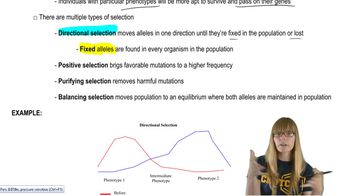Population geneticists study changes in the nature and amount of genetic variation in populations, the distribution of different genotypes, and how forces such as selection and drift act on genetic variation to bring about evolutionary change in populations and the formation of new species. From the explanation given in the chapter, what answers would you propose to the following fundamental questions?
How do we know whether the genetic structure of a population is static or dynamic?
Write a short essay describing the roles of mutation, migration, and selection in bringing about speciation.
 Verified step by step guidance
Verified step by step guidance
Verified video answer for a similar problem:
Key Concepts
Mutation

Migration

Selection

Population geneticists study changes in the nature and amount of genetic variation in populations, the distribution of different genotypes, and how forces such as selection and drift act on genetic variation to bring about evolutionary change in populations and the formation of new species. From the explanation given in the chapter, what answers would you propose to the following fundamental questions?
How do we know when populations have diverged to the point that they form two different species?
Population geneticists study changes in the nature and amount of genetic variation in populations, the distribution of different genotypes, and how forces such as selection and drift act on genetic variation to bring about evolutionary change in populations and the formation of new species. From the explanation given in the chapter, what answers would you propose to the following fundamental questions?
How do we know the age of the last common ancestor shared by two species?
Consider rare disorders in a population caused by an autosomal recessive mutation. From the frequencies of the disorder in the population given, calculate the percentage of heterozygous carriers:
0.0064
Consider rare disorders in a population caused by an autosomal recessive mutation. From the frequencies of the disorder in the population given, calculate the percentage of heterozygous carriers:
0.000081
Consider rare disorders in a population caused by an autosomal recessive mutation. From the frequencies of the disorder in the population given, calculate the percentage of heterozygous carriers:
0.09
